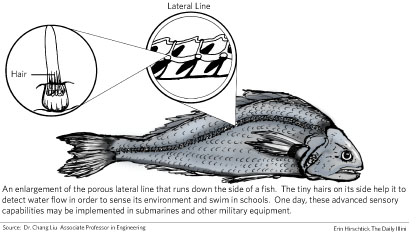Military interested in hairs that act as ‘eyes and ears’

Joseph Lamberson
September 25, 2006
The porous lateral line that allows the Blind Cave Fish to quickly slip around the multi-colored blocks of a maze in absolute darkness may be the future protection for submarines against bomb-planting scuba divers. Surprisingly, the story begins with a flying spider.
Faculty at the University are part of a team developing artificial hairs for the Defense Advanced Project Agency, the central research and development agency for the U.S. Department of Defense. The name of this project is called BioSenSE (Biology Sensory Structure Emulation) and is headed by Chang Liu, associate professor of Engineering.
Through the synergy of biology and engineering the team is charged with the development of micro-electro-mechanical systems that act as eyes and ears, allowing machines to actively respond to their environment.
“The equivalent of the lateral line sense of a fish does not exist in man-made vehicles,” Liu said. “That is the hole we are trying to patch.”
Tiny “hairs” are carved out of polymers and then rooted into a silicon base creating a lever. When the lever is moved by passing water it can calculate the electrical potential of the current in the water, which then correlates to a flow velocity. Manufacturing these tiny hairs, at about .5 mm in height, is about the only thing harder than explaining how they work.
Get The Daily Illini in your inbox!
“The issue we face is lack of equipment,” Liu said. “The physical tools for making those things; you have to invent them.”
Liu said that the team also has to invent the correct kind of signal processing algorithms so that the signal can be preserved.
However, the bigger issue is translating a technology that is so small to the larger scale, such as incorporating them into a submarine for new sensor capabilities. When the hairs are enlarged there is a larger distance from the sensor to the base, which can cause interference from other signals, such as radios.
Jan Walker, agency spokeswoman, said that these developments will have many useful applications, but are intended to be specifically applied to military technology.
“The Department of Defense is always interested in improving the capabilities of our sensors, and biological sensing systems have some unique capabilities,” she said in an e-mail interview. “If we succeed in emulating some of biology’s natural sensing capabilities, we will be able to develop more capable sensors for the U.S. military in the far future.”
The idea for this project came about when another member of the team, Joseph Humphrey, a Virginia Tech aerospace and mechanical engineer, witnessed a spider floating in the wind using its webbing. According to an article from The Daily Progress, a Charlottesville, Va. newspaper, this ignited a passion to learn how spiders knew how to do this; how they knew when the winds were just right.
This has been one of many military projects funded since the Sept. 11 attacks to bring about more innovative technology.
Liu said that in order to invent such advanced technologies, they must find out what already works.
“The hair cell on the leg of a spider can detect movement on the order of four angstrom,” Liu said. “The atom has a diameter of one angstrom. Unless you try to imitate that, you don’t know what you’re missing.”






